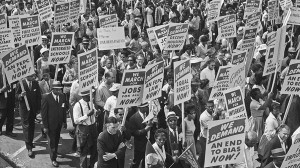The January Club Meeting will be held in the Lower Level of the LOW Clubhouse.
Category: Meetings
November club meeting
The November club meeting will feature member Diane Sibley talking about the creation of Shenandoah National Park on the land where her ancestors used to live.
November Steering Committee Meeting
The November Steering Committee meeting will be held at the home of Shirley Pfile.

August 28 of this year marks the 50th anniversary of the March on Washington for Jobs and Freedom, an event that changed the course of the civil rights movement in America.
The Lake of the Woods Democratic Club will observe the occasion at its meeting at 1:30 p.m., Thursday, Aug. 15, in the lower level of the LOW Clubhouse with a program of personal reminisences and an open discussion contrasting the expectations of 1963 with the realities of 2013.
Kerry Sipe, a club member and LOW resident who witnessed the march as a young man, will share his memories of the event and display some personal memorabilia from the march.
Following Sipe’s presentation, there will be an open discussion on the status of race relations in the United States.
Sipe, who was born in Lynchburg and grew up in Salem, Va., is a retired newspaper editor, whose early career as a journalist included coverage of the civil rights movement in the South. He has lived in LOW since 2009.
It was on Aug. 28, 1963, that about 250,000 people marched through Washington to call the nation’s attention to the injustice and inequalities that black Americans faced because of the color of their skin.
In support of civil rights for all Americans, the demonstrators made their way from the Washington Monument to the Lincoln Memorial, where the Rev. Martin Luther King Jr. gave his memorable and stirring “I Have A Dream” speech.
Despite the assurance in The Declaration of Independence that “all men are created equal.” nearly a century after the end of the Civil War people of color found themselves treated unfairly. They weren’t allowed in many public schools, they had to eat at separate restaurants and use separate bathrooms, and they had to pay taxes and pass literacy tests to vote. The idea was to keep blacks “separate but equal.”
By the late 1950s a movement had started. People were demanding laws to protect their civil rights — rights that all free Americans are guaranteed as citizens of this country.
In late 1962, civil rights activists started to organize what would become the largest civil rights demonstration in the history of the United States. It took a while, but by June 1963, they had put together an impressive group of leaders and speakers to help them.
The organizers of the march had to make sure people had a way of getting into the city. They had to make sure marchers knew where to go and what to do once they got there. They had to have doctors and nurses in case anyone needed first aid. They had to provide water, security, and be ready for any emergency. And they needed some way to pay for all of it. It was going to take fund raising, planning and lots of work.
On that hot, August day, the city swelled with marchers. They drove in. They bussed in. They took trains. Three student marchers walked and hitchhiked 700 miles to get there. A quarter million people waved signs and cheered and listened to speakers address the civil rights problems challenging America. The last speaker was Dr. King.
“I am happy to join with you today in what will go down in history as the greatest demonstration for freedom in the history of our nation,” King began. His ensuing speech is remembered as one of the corner stones of the civil rights movement.
A year later, Congress passed the Civil Rights Act of 1964, which made segregation in public places illegal, required employers to provide equal employment opportunities, and protected the right to vote of every American, regardless of the color of their skin.
August meeting
Fifty years after the March on Washington. What were our expectations for race relations in America then? What is the reality today?
